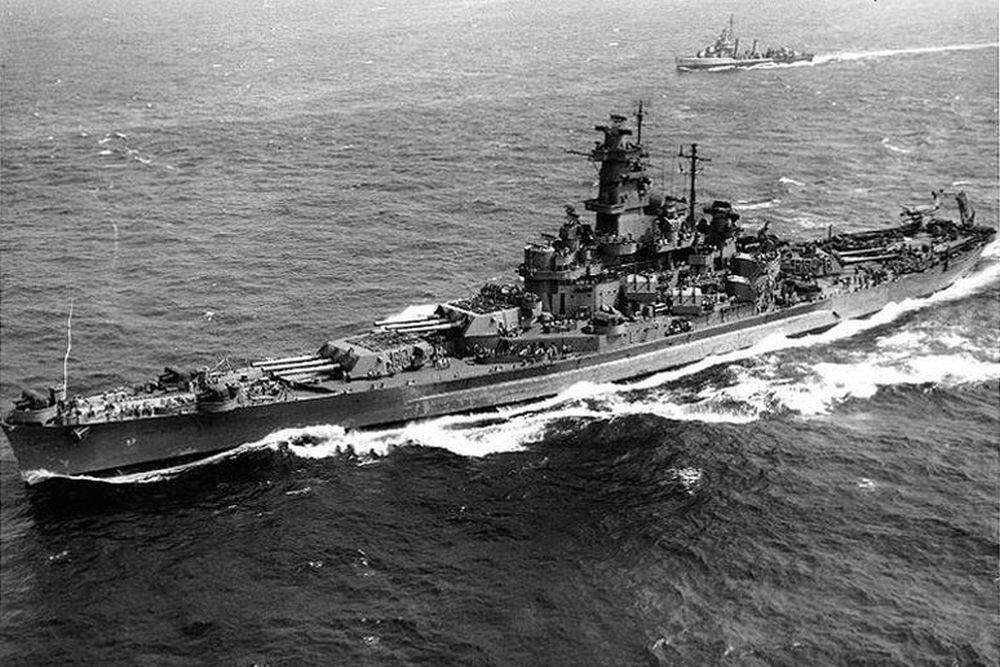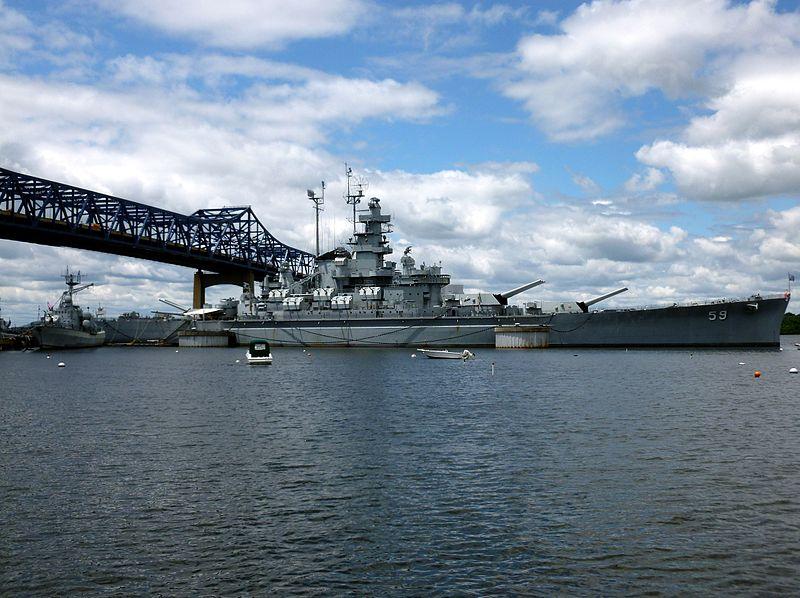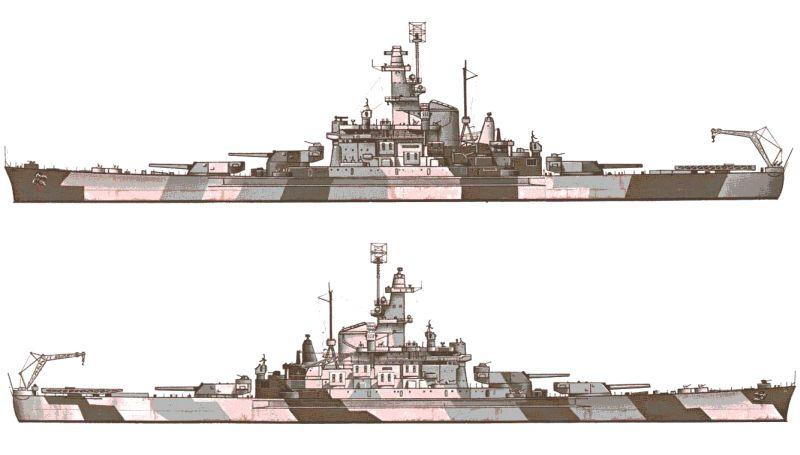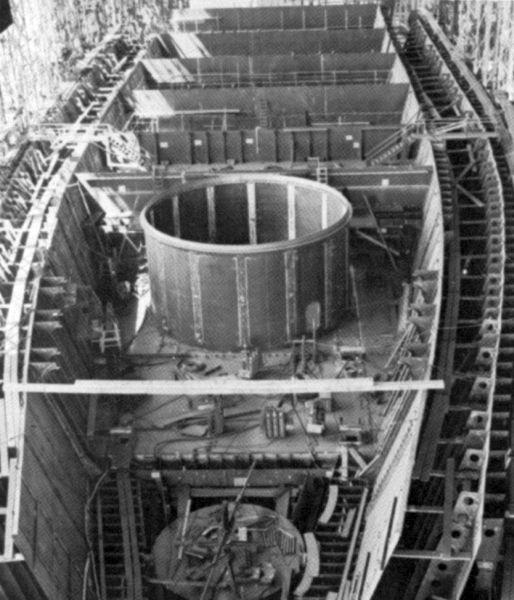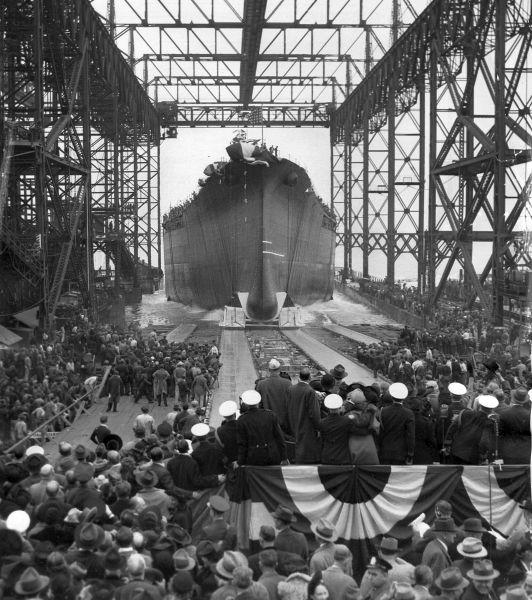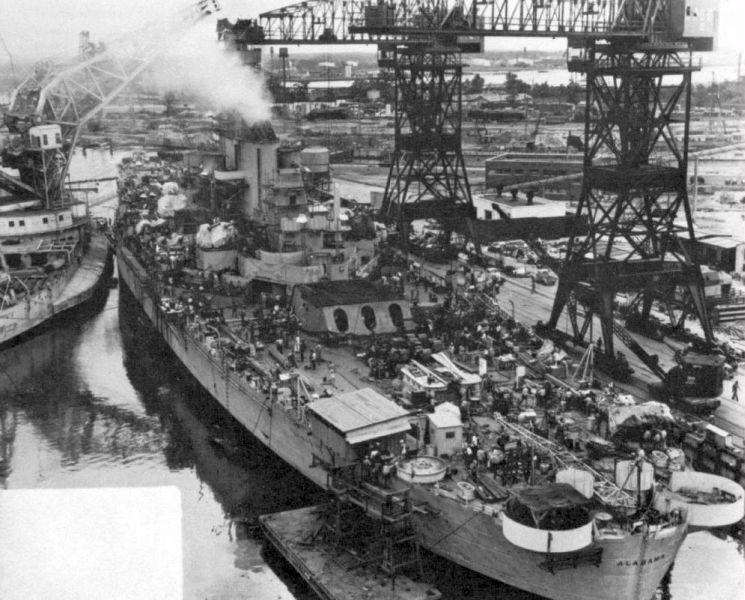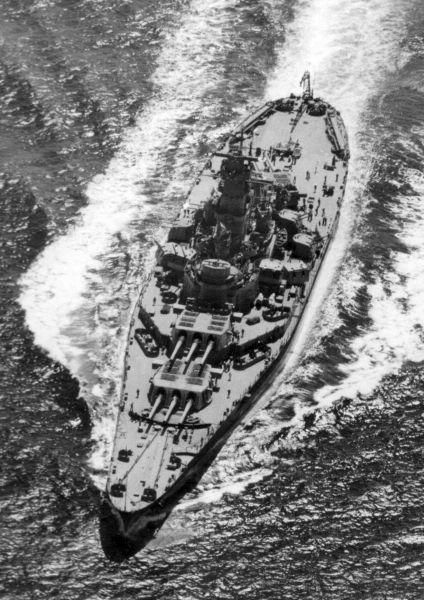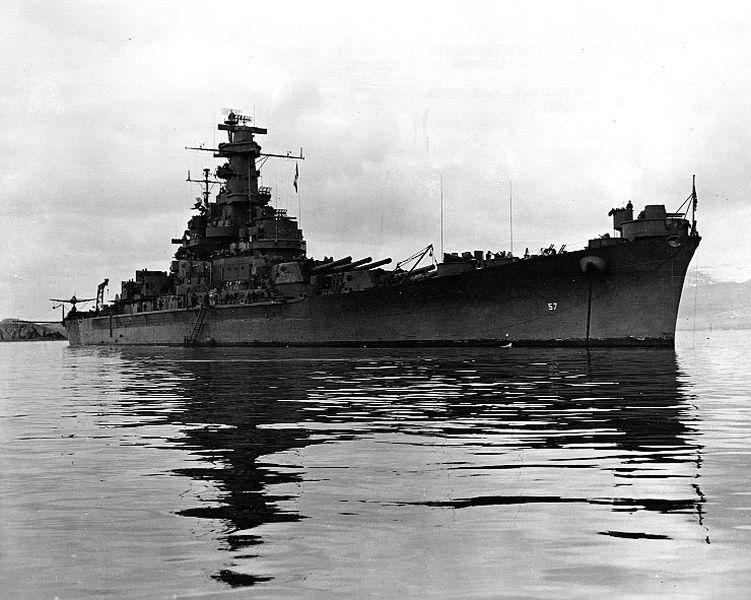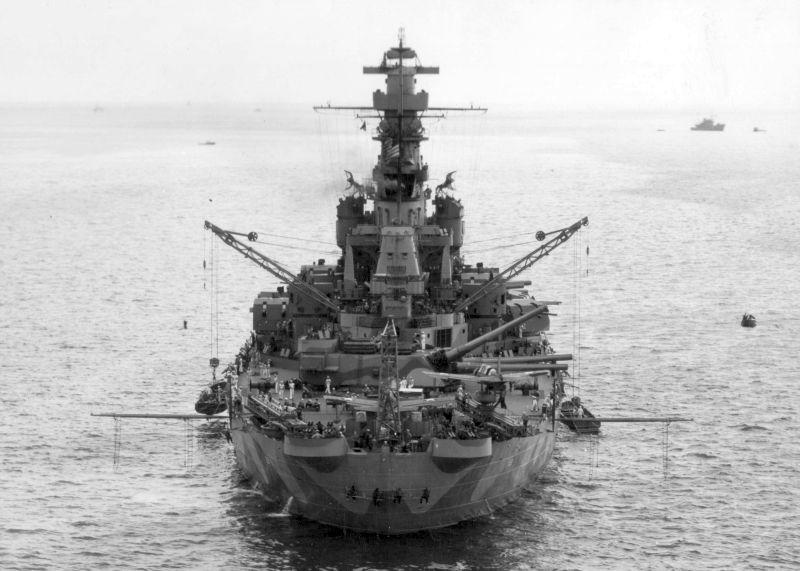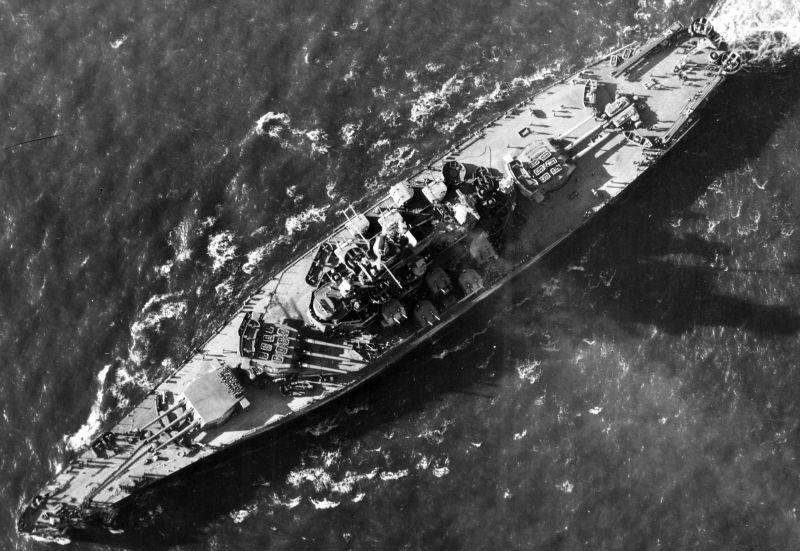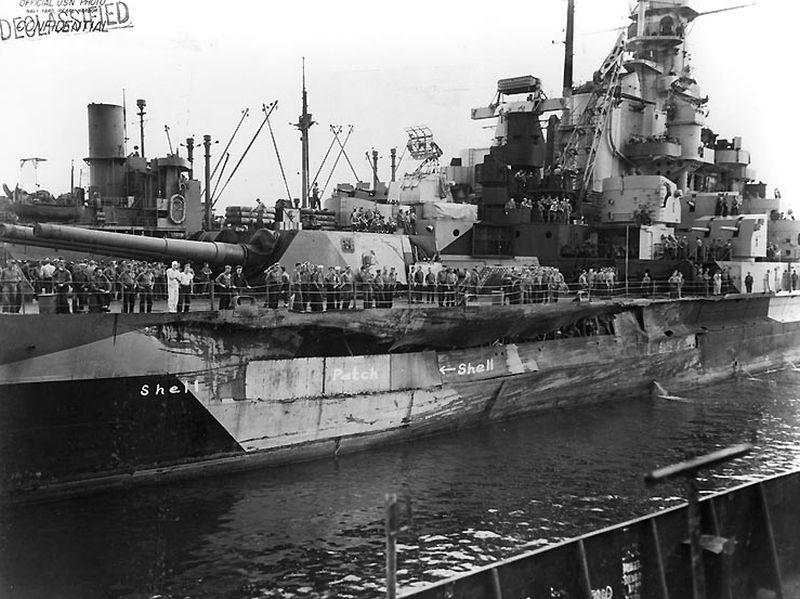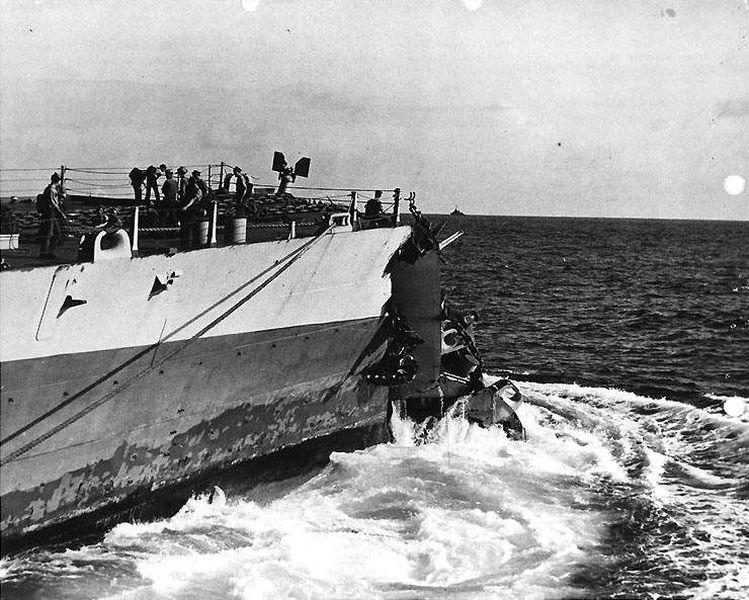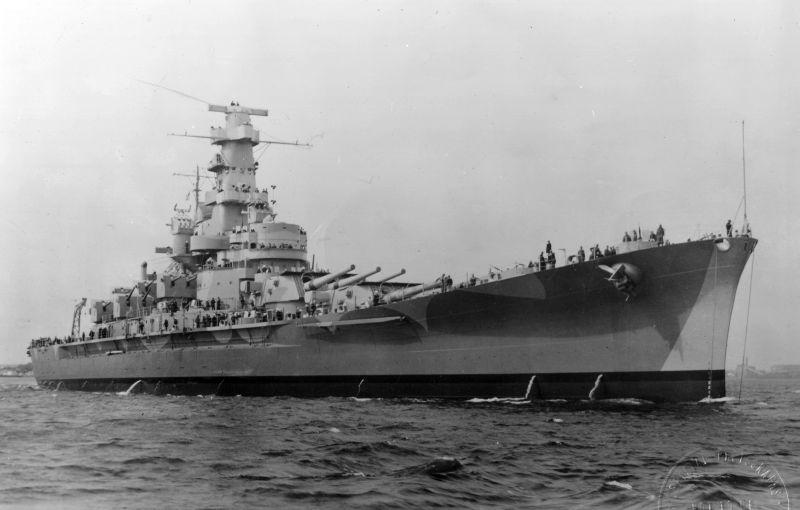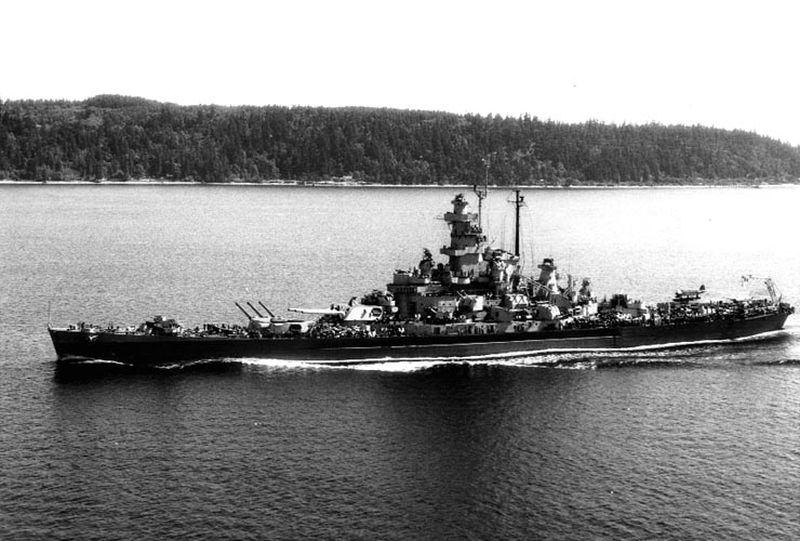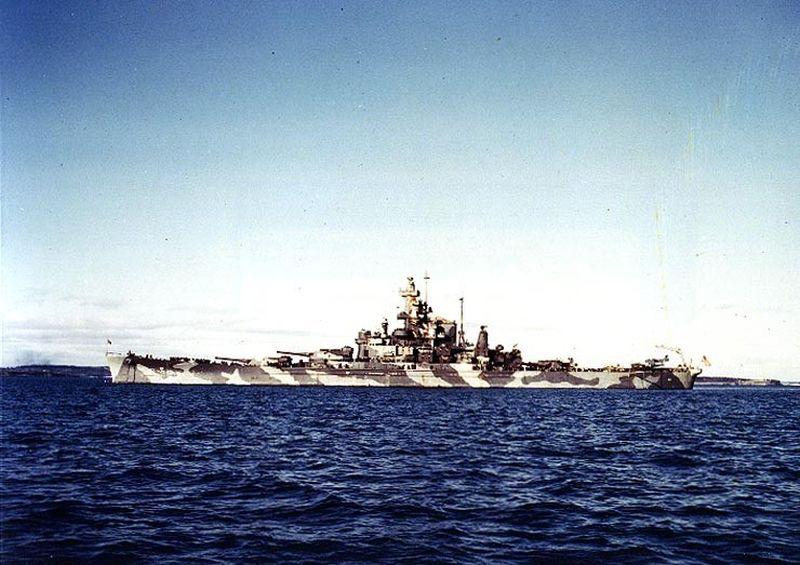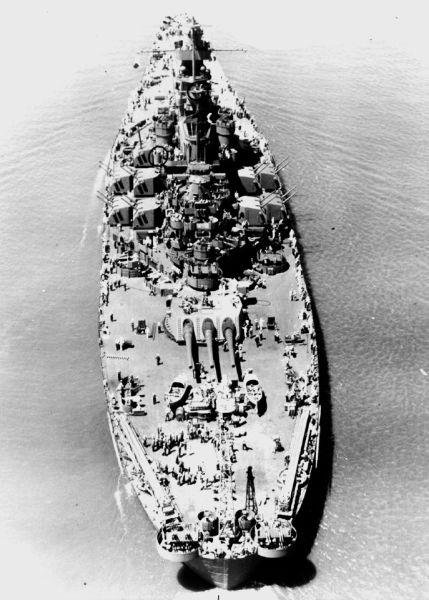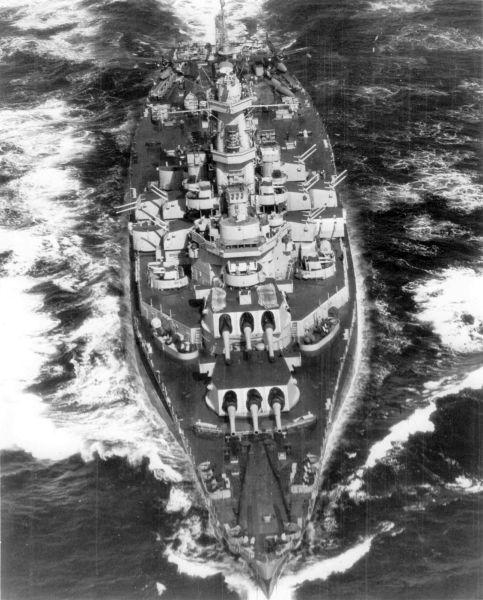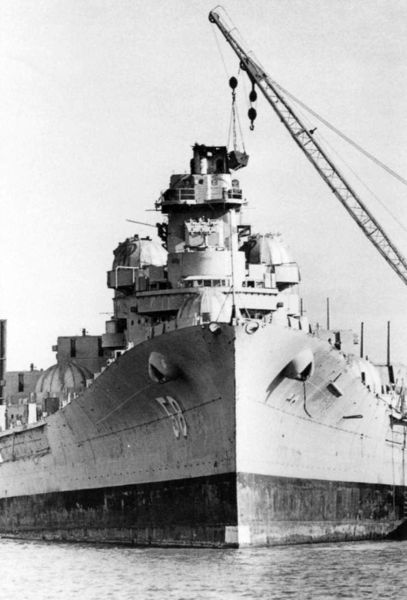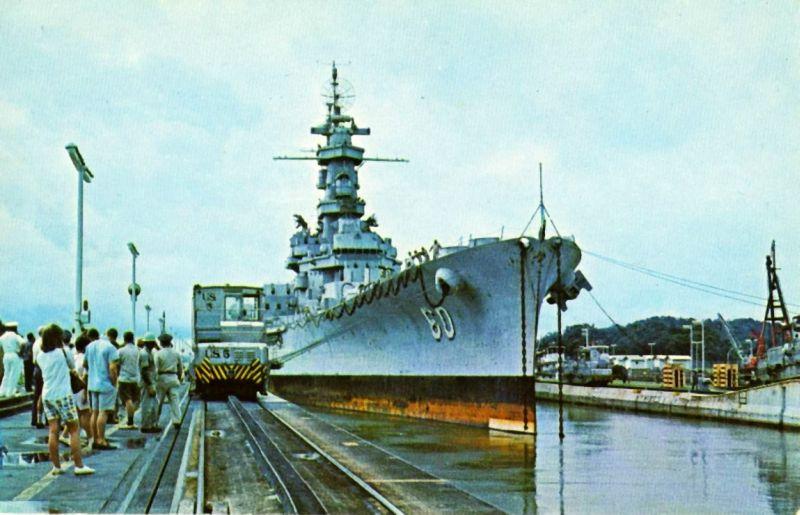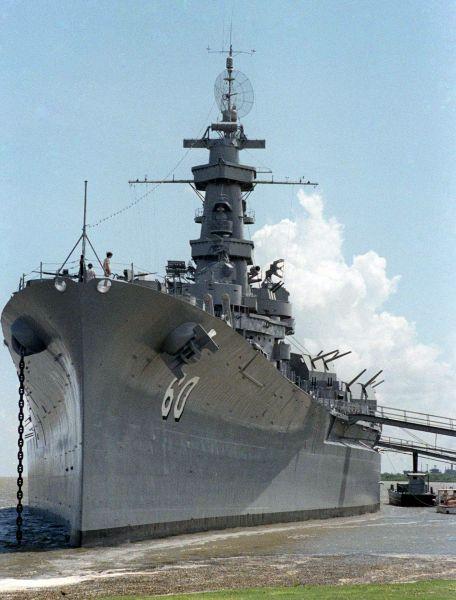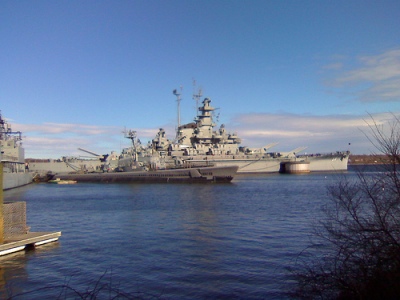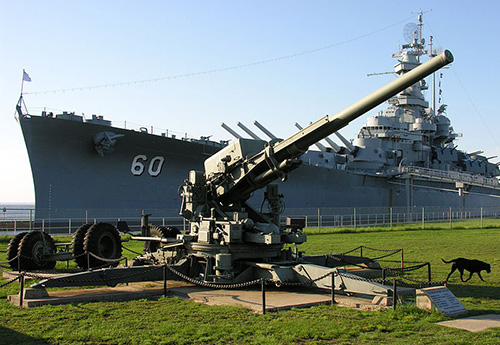Introduction
The American battleships of the South Dakota class (USS South Dakota, USS Indiana, USS Massachusetts and USS Alabama) were a class of fast battleships designed in the late 1930s under the constraints of the Washington and London Fleet Treaties. Compared to the preceding North Carolina class, the four battleships of the South Dakota class were more compact and better armoured but had the same primary armament.
History
The American battleships of the South Dakota class, USS South Dakota, USS Indiana, USS Massachusetts and USS Alabama, were a class of fast battleships designed in the late 1930s under the constraints of the Washington and London Fleet Treaties. Compared to the preceding North Carolina class, the four battleships of the South Dakota class were more compact and better armoured but had the same primary armament of 3 x 3 41cm 45-caliber guns. The two classes therefore looked very similar but could be easily distinguished because both ships of the North Carolina class had two smokestacks, whereas those of the South Dakota class only one.
[img]27241[/img]In the early 1920s, the keels had been laid of an earlier South Dakota class of battleships consisting of the South Dakota (BB-49), Indiana (BB-50), Montana (BB-51), North Carolina (BB-52), Iowa (BB-53) and Massachusetts (BB-54). The six vessels would have a standard displacement of 43,200 tons and be equipped with 4 x 3 41cm guns. The six hulls were sold for scrap in 1923 because of the provisions of the Washington Fleet Treaty.
The US General Board, the committee responsible for the US Navy's construction programs, advocated the construction of four North Carolina-class battleships in 1937. However, the Chief of Naval Operations, Admiral William H. Stanley, insisted that two of these would have an updated design and thus constitute a new class. Therefore, the USS North Carolina and USS Washington remained in the fiscal year 1937 budget and the two originally planned South Dakota class ships would be assigned to the fiscal year 1939 budget. This left financial room in the 1938 budget a total of four South Dakota-class battleships.
The engineers of the General Board proposed several designs before the building committee agreed to a final one. Because the maximum standard displacement of 35,000 tons, according to the Second Fleet Treaty of London, could not be exceeded and because the ships would have to be better armoured than the two battleships of the North Carolina class, the new battleships would have to be smaller in size. Because a beam of minimum 33 meters was required to ensure the stability of the battleships during the firing of the primary guns, only the length of the new battleships could be compromised. However, a shorter ship with the same beam size and the same propulsion system also meant a reduced maximum speed. As the ships required a speed of at least 27 knots to escort the fast aircraft carriers, the machine power performance had to be improved. To accommodate the larger steam turbines and boilers in a shorter hull, the engineers chose to position the boilers above the turbines. The shorter hull in combination with the greater propulsion power meant that the battleships were easier to manoeuvre and had a smaller turning circle than their predecessors.
Because space had to be sacrificed somewhere, this was ultimately at the expense of the crew's quarters. Even the officers' cabins and dining rooms were kept as small as possible so that the new battleships did not offer any luxury to any of the crew members. Furthermore, space was saved by omitting the usual ventilation shafts; the South Dakota-class battleships therefore became the first warships in the world with artificial air circulation. From a military perspective, the South Dakota class battleships were considered the best battleships ever built under the constraints of the prevailing fleet treaties. Because the USS South Dakota had to be able to function as a flagship and therefore accommodate the necessary flag officers and their staff, an extra deckhouse was built at the expense of two double 12.5 cm guns.
The four battleships of the South Dakota class were deployed from 1942 onwards in the Atlantic Ocean and the Mediterranean Sea, but above all in the Pacific. Due to their high speed, the ships were very suitable as escorts of aircraft carriers. Their excellent primary and secondary armament also made them suitable for carrying out coastal bombardments and supporting fire during amphibious landings. During the remainder of the Second World War, the four new battleships would continue to fulfil this dual role, like the USS North Carolina and the USS Washington.
Shortly after World War II, the South Dakota class battleships were incorporated into the reserve fleet. In 1962 and 1963, the USS South Dakota and the USS Indiana were sold for scrap, but both USS Massachusetts and USS Alabama were transferred to the two states of the same name where they can still be admired as a museum ship.
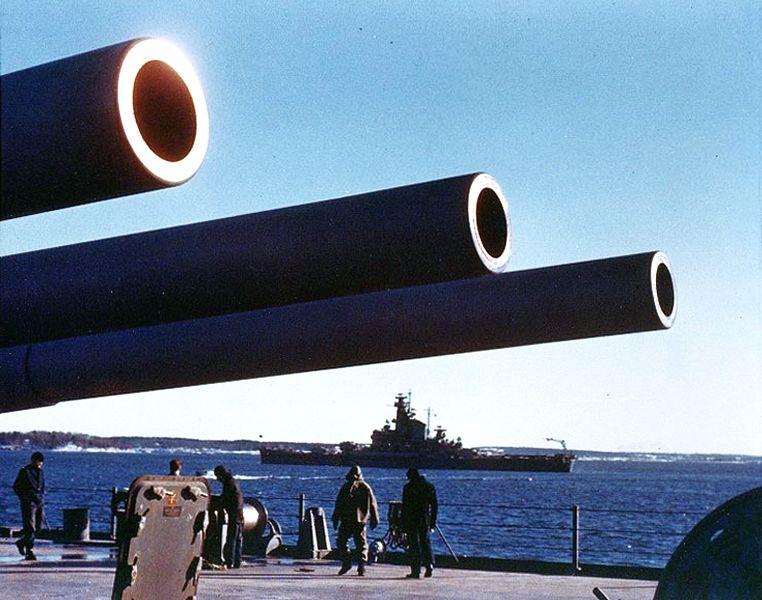
USS Massachusetts as seen from USS Alabama in Casco Bay, Maine, June 24, 1943. Source: Courtesy of Michael W. Pocock
Definitielijst
- caliber
- The inner diameter of the barrel of a gun, measured at the muzzle. The length of the barrel is often indicated by the number of calibers. This means the barrel of the 15/24 cannon is 24 by 15 cm long.
Class overview and technical specifications
Class overview
| USS South Dakota | USS Indiana | USS Massachusetts | USS Alabama | |
| Hull nr. | BB-57 | BB-58 | BB-59 | BB-60 |
| Shipyard | New York Shipbuilding Corporation, Camden, New Jersey | Newport News Shipbuilding and Dry Dock Company, Newport News, Virginia | Bethlehem Steel Corporation (Fore River Shipyard), Quincy, Massachusetts | Norfolk Naval Shipyard, Norfolk, Virginia |
| Ordered | December 15, 1938 | April 1, 1939 | ||
| Laid up | July 5, 1939 | November 20, 1939 | July 20, 1939 | February 1, 1940 |
| Launched | June 7, 1941 | November 21, 1941 | September 23, 1941 | February 16, 1942 |
| Commissioned | March 20, 1942 | April 30, 1942 | May 12, 1942 | August 16, 1942 |
| Fate | October 25, 1962, sold for scrapping | September 6, 1963, sold for scrapping | Museum ship at Fall River, Massachusetts since August 14, 1965 | Museum ship at Mobile, Alabama, since January 9, 1965 |
Technical specifications
| Overall length: | 207.5 meter |
| Beam: | 33.68 meter |
| Draft: | 10.465 meter |
| Displacement standard: | 35,000 tons |
| Displacement fully loaded: | 44,519 tons |
| Powerplant South Dakota and Massachusetts: | 4 x General Electric geared steam turbines, 8 x Babcock & Wilcox 3-drum Express Type boilers |
| Power plant Indiana and Alabama: | 4 x Westinghouse geared steam turbines, 8 x Foster Wheeler 3-drum Express Type boilers |
| Power capacity: | 130,000 shp |
| Propulsion: | 4 x 4-blade propellers |
| Bunkerage: | 6,500 tons fuel oil |
| Maximum speed: | 27.8 knots |
| Range: | 6,400 nmi at 25 knots, 17,450 nmi at 15 knots |
| Complement: | 1,793 crew |
| Complement in 1945: | 2,300 crew |
| Primary armament: | 3 x 3 41cm 45-calibre Mk6 guns |
| Secondary armament: | 10 x 2 12.5cm 38-calibre Mk 12 multipurpose guns (South Dakota: 8 x 2) |
| Anti-aircraft South Dakota: | 68 x 40mm Bofors and 77 x 20mm Oerlikon machine guns |
| Anti-aircraft Indiana and Alabama: | 48 x 40mm Bofors and 52 x 20mm Oerlikon machine guns |
| Anti aircraft Massachusetts: | 72 x 40mm Bofors and 41 x 20mm Oerlikon machine guns |
| Armour: | 292 - 330mm for belt, 254 - 406mm for main battery turrets, 406mm for conning tower, and 38 -154mm for deck |
| Aircraft carried: | 2 x Vought OS2U Kingfisher floatplanes |
When commissioned in March 1942, USS South Dakota had 28 28mm anti-aircraft machine guns, eight of which were replaced in September of that same year by 16 40mm Bofors and 36 20mm Oerlikon machine guns. During the Second World War these were expanded to the numbers mentioned in the overview above. The other three battleships of the South Dakota class never had the 28mm machine guns but were immediately equipped with the Bofors and Oerlikon machine guns until they reached the numbers listed in the overview in 1945.
USS South Dakota
Once USS South Dakota was commissioned and had an initial test run, she started her shakedown cruise which lasted from June 3 to July 26, 1942. After final adjustments, the new battleship departed from the Philadelphia Naval Shipyard on August 16 of that year and transited the Panama Canal five days later. The South Dakota headed for the Tonga Islands where she arrived on September 4. Two days later the battleship struck a coral reef in the Lahai Passage damaging its keel. On September 12, the ship departed for Pearl Harbor for repairs that would take a month.
From mid-October 1942, USS South Dakota was assigned to Task Force 16 (TF 16), a formation of escorts centred around the aircraft carrier USS Enterprise. TF 16 departed from Pearl Harbor on October 16 and joined TF 17, which was centred around the aircraft carrier USS Hornet. The American warships were ordered to patrol the Santa Cruz Islands, east of the Solomon Islands, and then to block Japanese naval units heading for Guadalcanal. These ship movements culminated in the Battle of Santa Cruz on October 26. During this battle between aircraft carriers, USS Hornet was lost and USS Enterprise was severely damaged. The South Dakota suffered extensive damage from a direct bomb hit on the forward 41cm turret. During the battle, the Japanese aircraft carrier Shokaku was also severely damaged, but more important were the large losses of Japanese aircraft and experienced pilots. USS South Dakota accounted for 26 of the 99 Japanese aircraft shot down during the battle.
The Japanese Navy sent eleven troopships carrying the entire 38th Infantry Division to Guadalcanal in late October 1942 to strengthen the island's defences. The transports were accompanied by the Kongo class (1912) battleships Kirishima (1915) and Hiei (1914), among others. The second task of these Japanese battleships was to bombard the airfield on Guadalcanal, Henderson Field, captured by the Americans. During the night of November 12 to 13, the Japanese battleships managed to inflict heavy damage on an American naval force of five cruisers and eight destroyers. However, on November 13, the Hiei (1914) was sunk by American aircraft. USS South Dakota and USS Washington, along with four destroyers, were sent to Guadalcanal to attack the Kirishima, which, along with four cruisers and nine destroyers, was threatening Solomon Island.
On November 14, the first clash took place between the two naval forces, during which the American destroyer USS Walke was sunk, and the other three destroyers were damaged. The Japanese were still planning to retake Henderson Field and on November 15 they made another attempt. USS South Dakota was the first to open fire on the Japanese ships and immediately scored several hits on a destroyer and a cruiser. By evening, the battleship approached the Japanese fleet to within 5,000 meters but could no longer deliver effective fire due to problems with its electrical power supply. The battleship was fired upon by almost all Japanese ships present and was hit by 27 heavy shells and 15 anti-aircraft bullets. As a result, the ship again suffered extensive damage and 38 of her crew were killed and more than 60 were injured.
Because the Japanese only paid attention to the South Dakota, USS Washington was able to approach unnoticed and fired on the Kirishima from 8,000 meters distance. Before the Japanese noticed what was happening, the Kirishima (1915) was hit by nine 41cm and forty 12.5cm shells from the American battleship, which were fired entirely under radar control. The Japanese cruisers and destroyers in turn attacked the Washington with torpedoes but were unable to score any hits. Both the South Dakota and the Washington were then able to escape. The Kirishima and the Japanese destroyer Ayanami were sunk the next day by their own crews because the damage suffered was too great.
The South Dakota was provisionally repaired by the crew of the repair ship USS Prometheus, after which the battleship left for the New York Naval Shipyard in Brooklyn for final repairs and major maintenance. The battleship arrived in New York on December 18, 1942. During the repair and maintenance period, one of the 41cm guns was renewed and all 28mm guns were removed. In addition, the number of 40mm and 20mm machine guns was expanded to 68 and 35 respectively. On February 25, 1943, USS South Dakota was ready to begin sea trials. The battleship then practiced with the carrier USS Ranger in the Atlantic Ocean until mid-April. From May 1943, USS South Dakota, together with her sister ship USS Alabama, was temporarily assigned to the British Home Fleet to deal with the threat of the German battleship Tirpitz. However, the Tirpitz remained hidden in the Norwegian fjords and the two American battleships left for the Pacific again in early August.
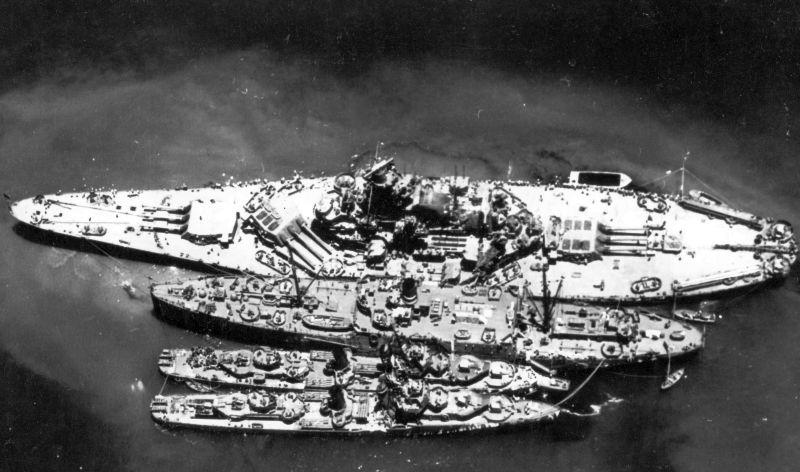
USS South Dakota and two destroyers alongside the repair ship USS Prometheus, November 14, 1942. Source: Navsource
On June 19, 1944, during the Battle of the Philippine Sea, USS South Dakota suffered a direct 500-pound bomb hit on the superstructure, destroying the squadron commander's and commander's quarters and causing further damage to the ship’s wiring and plumbing. Despite the damage and the 27 deaths and 23 injuries, the ship did not lose any effectiveness and remained at her post. That same day, two Japanese planes were shot down.
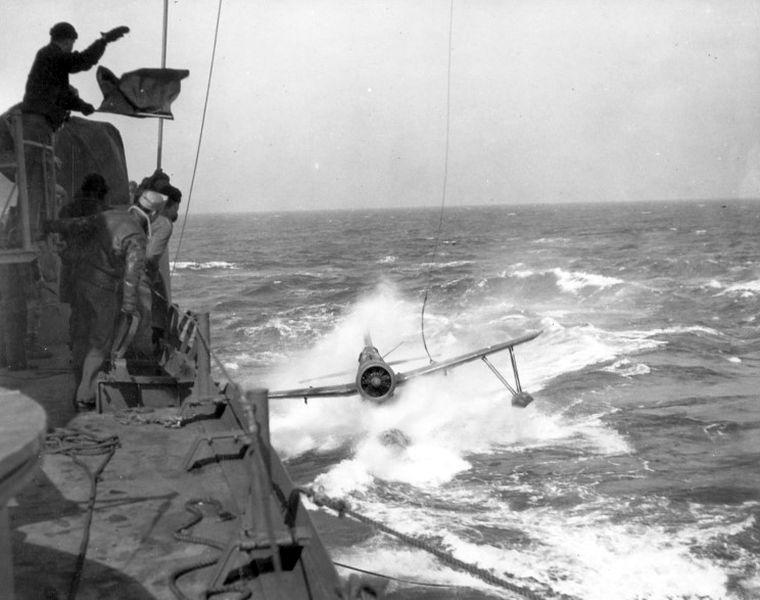
A Vought OS2U Kingfisher alongside the USS South Dakota, September 29, 1943. Source: Courtesy of Michael W. Pocock
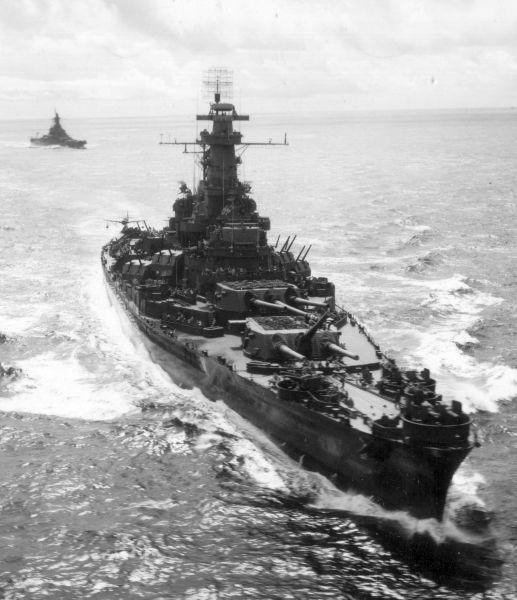
The South Dakota and the Alabama en route to the Marshall Islands, February 1, 1944. Source: Navsource
The battleship served for the remainder of the war as an artillery and anti-aircraft platform in the American attacks on the Philippines, Iwo Jima and Okinawa. On May 26, 1945, during the Okinawa campaign, the South Dakota replenished ammunition from the ship USS Wrangell. At one point, for unknown reasons, a 41cm powder container exploded while being transferred to one of the magazines. This resulted in 11 deaths and 24 injuries. During the summer of 1945, USS South Dakota's 41cm guns shelled the Japanese main islands and was part of the American occupation force from August 27 to September 20 while the battleship was anchored in Tokyo Bay. The battleship had shot down a record 64 enemy aircraft during the war.
Definitielijst
- battleship
- Heavily armoured warship with very heavy artillery.
- cruiser
- A fast warship with 8,000 – 15,000 ton displacement, capable to perform multiple tasks such as reconnaissance, anti-aircraft defence and convoy protection.
- destroyer
- Very light, fast and agile warship, intended to destroy large enemy ships by surprise attack and eliminating them by using torpedoes.
- Infantry
- Foot soldiers of a given army.
- mid
- Military intelligence service.
- radar
- English abbreviation meaning: Radio Detection And Ranging. System to detect the presence, distance, speed and direction of an object, such as ships and airplanes, using electromagnetic waves.
- Ranger
- American name for a specially trained soldier (similar to commando).
- shakedown cruise
- Navy slang for a sea trial when a navy vessel (post-construction of after a major overhaul) goes to sea for extensive testing and training, prior to become fully operational.
- squadron
- A military unit in the Belgian navy usually six to eight small ships operating together under one command. The smallest military unit in the Dutch air force of about 350 men. In most countries is the designation of a military unit thesize of a company. It is either an independent unit, such as a battery, or part of a bigger Calvary unit. In the air force it is the designation of a unit of aircrafts.
USS Indiana
After USS Indiana was commissioned on April 30, 1942, an intensive period of sea trials and exercises followed to prepare the battleship and her crew for war. As of November 15 of the same year, she replaced her sister ship South Dakota in the Guadalcanal campaign after the latter had been damaged during combat with Japanese warships. For the next eleven months, USS Indiana was part of the air defence screen protecting the aircraft carriers USS Enterprise and USS Saratoga.
On October 21, 1943, USS Indiana sailed for Pearl Harbor for maintenance and three weeks later joined the fleet that was to support the invasion of the Gilbert Islands. During the battle for Tarawa, the battleship crew shot down their first enemy aircraft. In January 1944, the battleship was part of the bombardment group preparing the invasion of the Marshall Islands. The 41cm guns of USS Indiana shelled Japanese positions on Kwajalein for eight days.
On February 1, 1944, the Indiana had a serious collision with the North Carolina-class battleship USS Washington. While on a zigzag course at a speed of 19 knots, the Indiana signalled that she was leaving the formation to refuel several destroyers. In the darkness, the battleship left the formation too abruptly and thereby blocked the Washington’s course. Although the latter made every effort to slow down and avoid collision, the battleship USS Indiana rammed her starboard side near the aft 41cm turret at an angle of approximately 26 degrees. The Indiana suffered extensive damage to the hull, from the main deck down to the underwater armour. A total of 14 watertight compartments were flooded and 13 fuel tanks were punctured. The outer starboard propeller shaft was so badly damaged that it had to be replaced. Furthermore, electricity lines and degaussing cables were interrupted, and some trusses were twisted. Two quadruple 40mm machine guns and fourteen single 20mm Oerlikons were completely destroyed and the starboard catapult with the Vought OS2U float plane mounted on it had to be considered lost. In addition, three people were killed and one injured because of the collision.
The bow of the Washington was crumpled by up to 60 feet in the collision. The two damaged battleships sailed at six knots, escorted by four destroyers, bound for Majuro, Marshall Islands, for emergency repairs and from there to Pearl Harbor. The commander of USS Indiana, Captain Aaron Stanton Merril, immediately admitted that he had made a big mistake and left the formation too quickly. Admiral Chester Nimitz, the commander of the US Pacific Fleet, relieved him of his duties on February 23. Repairs to the battleship lasted until the end of April 1944.
From the end of April 1944, USS Indiana participated successively in the campaigns in New Guinea, the Carolines and the Mariana Islands. During the Battle of the Philippines Sea, on June 19, 1944, a torpedo was launched at the Indiana by a Japanese torpedo bomber, but both aircraft and torpedo were neutralised by 20mm machine gun fire. A second torpedo bomber was shot down, but it crashed into the stern of the battleship, injuring five. Later in 1944, USS Indiana shelled the coasts of several Philippine islands in preparation for the amphibious landings of US Marines. On October 23, the battleship arrived at the Puget Sound Naval Yard in Bremerton, Washington State for major maintenance. During this overhaul, the battleship's anti-aircraft battery was expanded to 48 40mm and 52 20mm machine guns.
By the end of January 1945, the battleship was fully operational again and was part of the Bombarding Group that supported the landings on Iwo Jima and the Japanese main islands. During the Okinawa campaign, USS Indiana was attacked by three kamikazes, but the battleship's gun crew took them all down before they could cause any harm. On August 30, 1945, the battleship assisted in the landings of occupying troops at the Yokosuka Naval Base. On September 5, the battleship anchored in Tokyo Bay for a period of nine days.
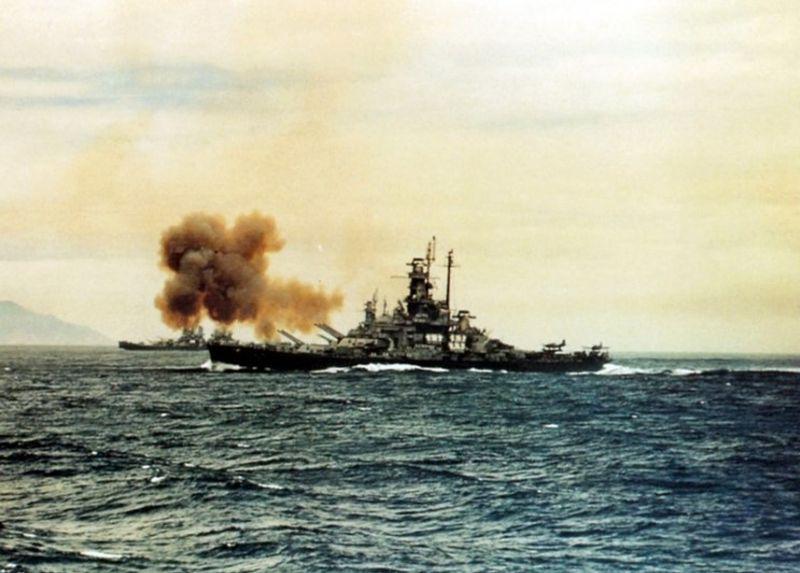
USS Indiana shells the Japanese coast at Kamaishi, July 14, 1945. Source: Courtesy of Michael W. Pocock
Definitielijst
- battleship
- Heavily armoured warship with very heavy artillery.
- invasion
- Armed incursion.
- machine gun
- Machine gun, an automatic heavy quick firearm.
- torpedo
- A weapon of war. A cigar shaped body fitted with explosives and a propulsion and control mechanism. Intended to target after launch a nearby enemy ship and disable it by underwater explosion.
USS Massachusetts
After her sea trials and training period, USS Massachusetts was assigned to the American-British fleet that would support Operation Torch, the conquest of western North Africa from Vichy France, in the first joint action by British and American landing forces. USS Massachusetts, escorted by the cruisers USS Tuscaloosa and USS Wichita and four destroyers, became the flagship of the Western Naval Task Force. The Task Force was ordered to support the landings on Vichy French Moroccan territory, where the Vichy French warships in Casablanca posed a major threat. In the evening of November 7, 1942, the Massachusetts and her escorts appeared on the horizon of the Moroccan port city.
The next morning the American ships took up their positions. At 07:03, five shells fired from the El Hank coastal battery and aimed at the starboard side of the American battleship fell into the sea. The Americans thought that the shelling originated from the uncompleted French Richelieu-class battleship Jean Bart, which had escaped to Morocco in June 1940. However, this battleship only fired its first shots at the American fleet five minutes later. USS Massachusetts then fired on the Jean Bar hitting her with five 41cm shells, disabling the only working primary 38cm turret of the Vichy French battleship. Other hits from the American battleship damaged port installations and merchant ships, two of which sank in the harbour. The American troopships were protected by the cruisers USS Augusta and USS Brooklyn that were likely no match for the attacking Vichy French force of cruisers and destroyers. The American cruisers were then joined by the USS Massachusetts and the heavy cruiser USS Tuscaloosa that opened fire on the French ships.
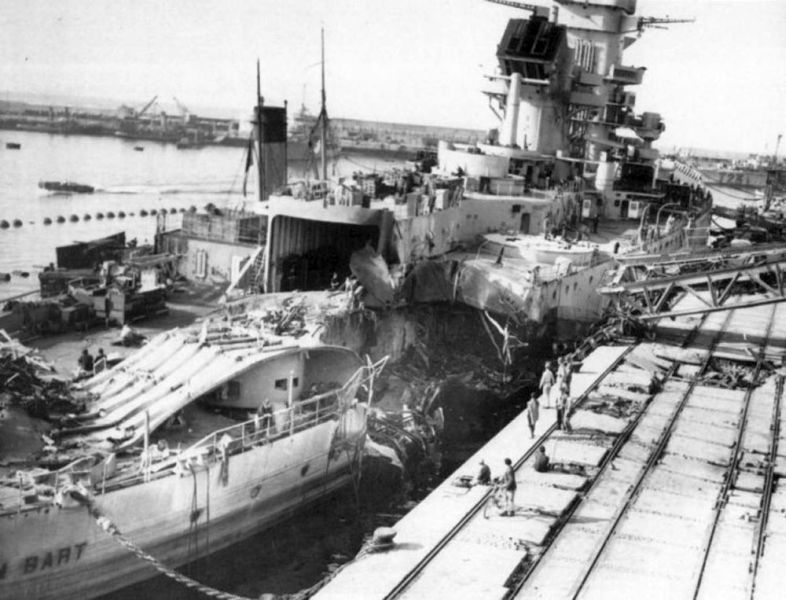
The heavily damaged Vichy French battleship Jean Bart in Casablanca, November 8, 1942. Source: Navsource
The Vichy French destroyer Fougeaux was sunk by hits from the Tuscaloosa and a single 41cm hit from the Massachusetts, after which the American battleship had to avoid four torpedoes that were probably launched by a Vichy French submarine. At 10:35, a 41cm shell from the Massachusetts struck the enemy destroyer Milan while the American battleship itself took a hit from the destroyer Boulonnais. The hit did little harm to the armour of the new battleship and the Bolonnais in turn was attacked and sunk by the USS Massachusetts and USS Brooklyn. Moments later, the Vichy French cruiser Primaquet was severely damaged by USS Massachusetts and USS Augusta. Around noon on November 8, USS Massachusetts attacked the enemy gunboat LA Grandiere, two minesweepers and the coastal battery El Hank. The Western Naval Task Force firefight was only a small part of the overall naval battle of Casablanca, which became a total American victory and paved the way for the Allied amphibious landings in North Africa.
After a major overhaul at the Boston Naval Yard, where USS Massachusetts was prepared for battle in the Pacific, the battleship reached Nouéma in New Caledonia on March 4, 1943. From here the battleship protected the shipping lanes around the Solomon Islands and the New Hebrides over the coming months. Later in 1943, during the Gilbert Islands campaign in November, USS Massachusetts shot down the first two enemy aircraft. During the remainder of the war the battleship operated in the Pacific and was involved in the battles for Nauru, Kwajalein, Truk, the Carolines, Okinawa, the Chinese east coast and Japan. The battleship also took part in the Battle of the Philippines Sea and the Battle of Leyte Gulf.
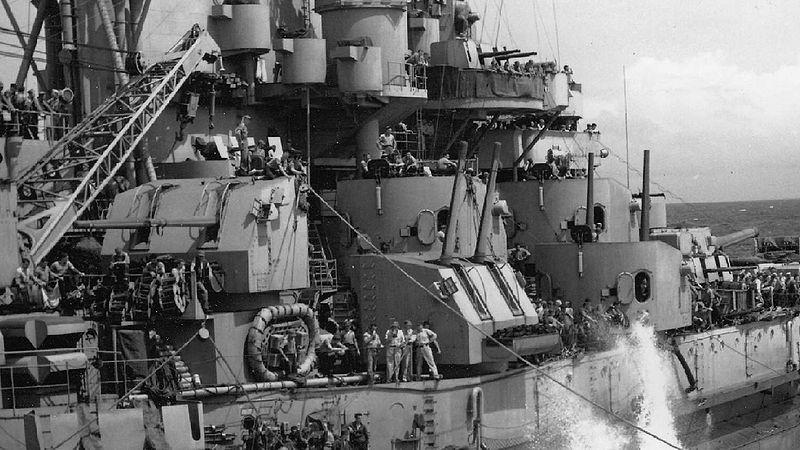
The starboard 12.5cm guns of USS Massachusetts seen from a supply ship, October 17, 1944. Source: Wikipedia
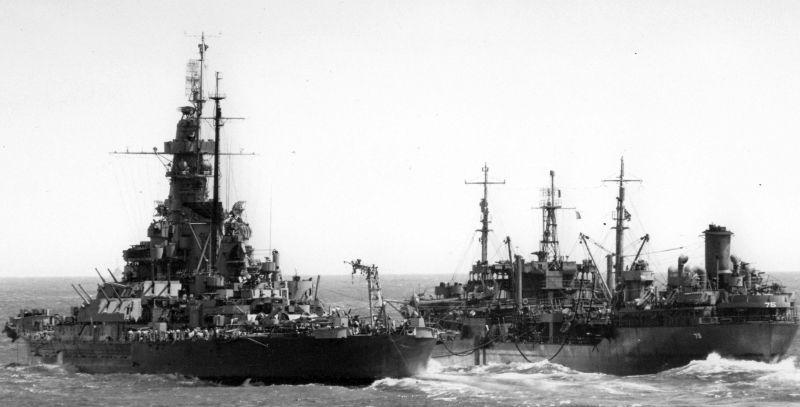
USS Massachusetts is supplied with fuel from the replenishment oiler USS Saugatuck, April 20, 1945. Source: Navsource
Definitielijst
- battleship
- Heavily armoured warship with very heavy artillery.
- cruiser
- A fast warship with 8,000 – 15,000 ton displacement, capable to perform multiple tasks such as reconnaissance, anti-aircraft defence and convoy protection.
- destroyer
- Very light, fast and agile warship, intended to destroy large enemy ships by surprise attack and eliminating them by using torpedoes.
- shelling
- Indication for shooting targets with grenades. Both from artillery and armoured artillery.
USS Alabama
USS Alabama had her shakedown in Chesapeake Bay, east of Virginia, in November 1942. In late 1942, ship and crew underwent further trials out of Casco Bay, Maine. From here a lot of practice training took place with her sister ship USS South Dakota, which again underwent trials after its repair period in New York. On April 2, 1943, USS Alabama, USS South Dakota and five destroyers departed as Task Force 22 (TF 22) for the Orkney Islands, north of Scotland, to temporarily become a unit of the British Home Fleet. From 19 May, TF 22 was stationed at Scapa Flow, the base of the British Home Fleet in Scotland. From here the American ships were part of the convoy protection to and from Murmansk in Russia. Because the greatest threat to these Arctic Convoys, the German battleship Tirpitz, remained hidden in the Norwegian fjords, the American ships returned to the United States in August to become part of the US Pacific Fleet.
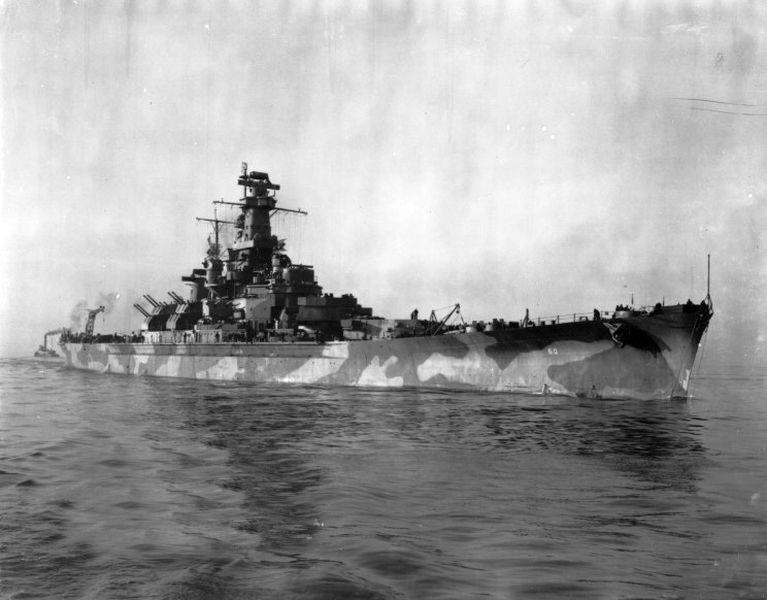
USS Alabama during a sea trial in Chesapeake Bay, Virginia, November 1942. Source: Courtesy of Michael W. Pocock
After an intensive training period with fast carrier groups, USS Alabama headed for Fiji, where the battleship arrived on November 7, 1943. From here the ship took part in the reconquest of the Gilbert Islands. In early 1944, the battleship was part of the bombardment groups preparing the invasions of the Marshall Islands, Kwajalein and Majuro. On February 21, 1944, during the bombardment by some enemy aircraft, one of the USS Alabama’s 12.5 cm guns accidentally fired at one of her own 12.5 cm turrets. This accident left five dead and eleven injured. Although a mechanical device had been fitted to all 12.5cm turrets that interrupted the firing mechanism when the turrets were turned to a certain angle, the accident could still have occurred. Further investigation revealed that the mechanical safety catches were not functioning properly due to damage caused spraying seawater. To prevent such accidents in the future, the safety catches on all American battleships were covered with iron plates.
During the remainder of World War II, USS Alabama was part of the screening force protecting the fast aircraft carriers USS Bunker Hill, USS Enterprise and the new Essex class (1942) USS Yorktown (CV-10). As part of this force, the battleship took part in the American air raids on the Caroline Islands of Palau, Yap, Uliti and Woleai in March 1944 and New Guinea a month later. In May and June of that year the bombings and invasions of the Northern Mariana Islands followed. In June the battleship took part in the Battle of the Philippines Sea and in subsequent month the coastal bombardment of Guam to prepare for the American invasion of this southernmost island of the Northern Marinas and finally the liberation of the Philippines.
In early 1945, USS Alabama underwent major maintenance at the Puget Sound Naval Yard and was operational again in May. As part of the screening force surrounding the aircraft carrier USS Enterprise, the battleship was involved in air raids on Okinawa and Kyushu, Japan's largest southern islands. On May 14, the American fleet was attacked by five kamikazes. One crashed into the USS Enterprise, but the other four were shot down before they could do any harm, two of them by the Alabama. USS Alabama's final act of war was to bombard the Japanese coasts in July and August until the Americans could land their occupation forces.
Definitielijst
- battleship
- Heavily armoured warship with very heavy artillery.
- invasion
- Armed incursion.
Post-war
USS South Dakota left Tokyo Bay on September 20, 1945, and sailed via San Francisco to San Pedro near Los Angeles. On January 3, 1946, the South Dakota left the American west coast for an overhaul at the Philadelphia Naval Shipyard in preparation for deactivation. On January 31, 1947, the battleship was inducted into the Atlantic Reserve Fleet. On June 1, 1962, the ship was permanently decommissioned and sold for scrap to the Lipsett Division of the Luria Brothers & Co on October 25 of the same year. Part of the demolition contract stipulated that Luria Brothers would deliver 6,000 tons of the vessel’s armour steel to the United States Atomic Energy Commission for use in small-scale nuclear tests. A memorial of the battleship was erected in Sioux Falls, the capital of the state of South Dakota. That memorial consists of a low wall structure outlining de main deck, within which a number of the ship’s parts are placed. USS South Dakota received no fewer than thirteen Battle Stars for her role in World War II.
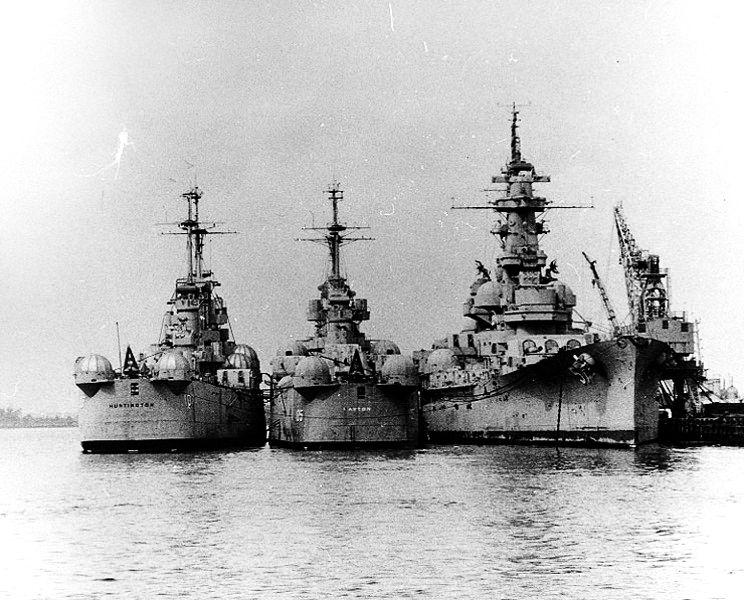
The South Dakota, together with the light cruisers Dayton and Huntington in the Atlantic Reserve Fleet at Philadelphia, August 1961. Source: Courtesy of Michael W. Pocock
On September 14, 1945, USS Indiana left Tokyo Bay and headed for the Puget Sound Naval Shipyard where the battleship was to be preserved. In 1947 the ship was inducted into the Pacific Reserve Fleet at the Naval Base in Bremerton, Washington State. On June 1, 1962, the Indiana was finally taken out of service and sold for scrap on September 6, 1963, and dismantled a year later. Several relics of the battleship, which received a total of nine Battle Stars, are scattered throughout the state of Indiana including her mainmast, an anchor and the ship's bell.
USS Massachusetts departed for maintenance at the Puget Sound Naval Shipyard on 1 September 1945 and patrolled off the US West Coast from January to April 1946. On March 27, 1947, the battleship was inducted into the Atlantic Reserve Fleet at Norfolk, Virginia. On June 1, 1962, the ship was finally taken out of service and saved from demolition by the USS Massachusetts Memorial Committee, which was founded by residents of the state of Massachusetts. On June 8, 1965, the battleship was transferred to the foundation, which had it moored in Fall River, Massachusetts. From August 14 of the same year, the museum ship was opened to the public to serve as a tribute to those of the state of Massachusetts who had fallen during the Second World War. On January 14, 1986, the museum ship USS Massachusetts was declared a National Historic Landmark by the federal government. This status will protect the battleship, which earned eleven Battle Stars during World War II, from decay or demolition in the future.
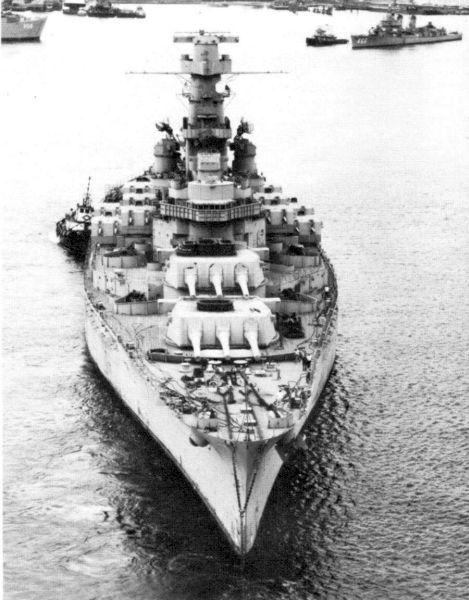
The Massachusetts en route to Fall River to serve as a museum ship and memorial, 1965. Source: Navsource
USS Alabama participated in Operation Magic Carpet in September and October 1945 by repatriating 700 Marines from Okinawa. On October 15, the battleship arrived in San Francisco, from where it sailed to San Pedro naval base near Los Angeles where it remained until February 27, 1946. The Alabama then left for the Puget Sound Naval Shipyard for preservation. On January 9, 1947, the battleship was inducted into the Pacific Reserve Fleet at Bremerton and was finally taken out of service on June 1, 1962.
The state of Alabama had meanwhile established the USS Alabama Battleship Commission with the aim of preserving the battleship as a museum ship and memorial. On June 16, 1964, this request was honoured by the US Navy and the foundation was able to purchase the Alabama at scrap value. The official transfer took place in Seattle on July 7 of that year and the ship was then towed by tugboats, through the Panama Canal, to Mobil, Alabama, and moored in Battleship Memorial Park on September 14. On January 9, 1965, the battleship, which had received nine Battle Stars for services rendered during the Second World War, was opened to the public as a museum ship and memorial. Like her sister ship USS Massachusetts, USS Alabama was awarded National Historic Landmark status in 1986.
The four battleships of this class were called the best battleships built under the restrictions of the fleet treaties as the US Navy designers had been able to remedy the shortcomings of the North Carolina-class battleships. This is proven by their excellence in executing a dual role as escorts of fast aircraft carriers and as artillery platforms, whereby the battleships suffered relatively little damage from enemy action. In 1954, the US Navy submitted a proposal to convert the South Dakota battleships, which had performed so well during World War II, into even faster attack battlecruisers. This would require removing the rear 41cm tower to make room for additional steam turbines. The propulsion system would then have to generate a total of 256,000 shp to reach a maximum speed of 31 knots. However, the shape of the hull and superstructure would also have to be adjusted, which would cost 40 million dollars per ship. Considering these costs and despite their excellent reputation, the South Dakota-class battleships remained in the reserve fleet.
The South Dakota-class battleships were succeeded in 1943 and 1944 by the four Iowa-class battleships, USS Iowa, USS New Jersey, USS Missouri and USS Wisconsin. The design for these battleships was no longer limited by the Washington and London treaties, which were revoked with the outbreak of the Second World War. This allowed the US Navy designers to run their own course, resulting into four battleships with a standard displacement of 45,000 tons, a total length of over 262 meters and a maximum speed of over 31 knots.
Definitielijst
- battleship
- Heavily armoured warship with very heavy artillery.
Information
- Article by:
- Peter Kimenai
- Translated by:
- Simon van der Meulen
- Published on:
- 18-01-2025
- Feedback?
- Send it!
Related sights
Sources
- DULIN, R.O. JR. & GARZKE, W.H.JR., Battleships, Naval Institute Press, Annapolis, Maryland, 1976.
- HORE, P, Slagschepen, Veltman Uitgevers, Utrecht, 2006.
- LYON, H, Encyclopedie van de belangrijkste oorlogsschepen ter wereld, Scriptoria, Antwerpen, 1980.
- MCCURTIE, F.E., Jane`s Fighting Ships of World War II, Military Press, New York, 1989.
- TERZIBASCHITSCH S., Battleships of the US Navy in World War II, Bonanza Books, New York, 1977.
- Maritiem Gezien, Volume 2, number 4 1985
- Maritiem Gezien, Volume 2, number 5 1985
- NavSource Naval History
- Naval History and Heritage Command
- MaritimeQuest
- HistoryCentral
- Wikipedia
- World War II Database
